Zanzibar Gem Care Guide
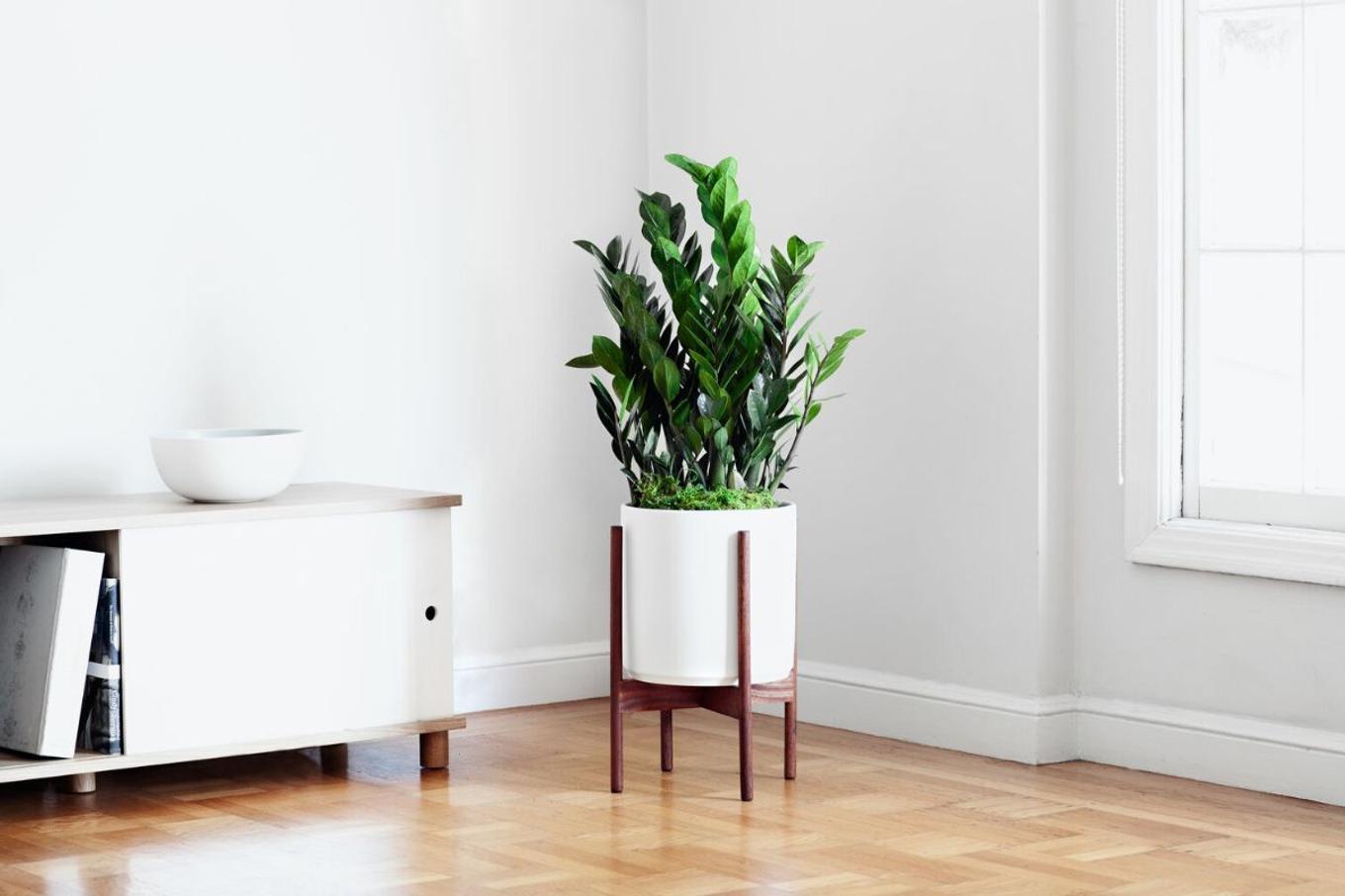
With elegant, wand-like stems and glossy emerald-green leaves, the Zanzibar Gem is a striking choice for any home or office. Its remarkable resilience—thriving even with minimal light and care—has earned it the nickname “the eternity plant.” Discover the essentials of ZZ plant care, from ideal lighting and watering routines to troubleshooting common issues.
Simple Care Instructions for the Zanzibar Gem
Light Requirements
The Zanzibar Gem thrives in bright to medium indirect light but is incredibly adaptable, even tolerating low light and fluorescent overhead lighting. Embrace your ZZ plant in dimly lit spaces—it’s a resilient choice for corners and rooms with minimal natural light, though keep in mind it will grow more slowly.
Watering Needs
The Zanzibar Gem efficiently stores water in its thick roots, stems, and leaves, allowing it to go long periods without watering. Water every one to two weeks depending on your plant's conditions, or gauge when it's time to water by feeling the top two inches of the soil--if it's completely dry, you can water.
As with most common houseplants, the Zanzibar Gem being absolutely no exception, t’s best to underwater rather than overwater, and expect to water even less frequently during the winter months.
Need some assistance with watering? Use a moisture meter for a more precise gauging of when to water. Shop our favorite minimalist moisture meter here.
Humidity and Temperature
The Zanzibar Gem thrives in average household temperatures between 65–75°F (18–24°C) and can tolerate occasional dips but should be kept away from cold drafts and absolutely never exposed to freezing temperatures. It adapts well to typical indoor humidity levels and doesn’t require extra moisture, though it benefits from misting or a nearby humidifier in very dry environments.
Soil and Fertilizing
Plant your ZZ in a well-draining potting mix to promote aeration and prevent waterlogging. Since the Zanzibar Gem is technically a succulent, a cactus or succulent mix is ideal for maintaining a healthy root system and avoiding excess moisture buildup. To encourage steady growth, feed your ZZ plant with a balanced liquid fertilizer once or twice a month during the growing season in spring or summer. In fall and winter, you can reduce or pause fertilizing.
Common Problems and Troubleshooting Tips
Brown Tips
Symptoms: Brown, dry, or crispy tips on the leaves.
Cause: Brown tips on a ZZ plant are often caused by underwatering, low humidity, or a buildup of minerals from tap water. Excess fertilizer or exposure to cold drafts can also contribute to the issue.
Solution: Ensure you’re watering consistently, allowing the top two inches of soil to dry out between waterings but not letting the plant go too long without moisture. Use filtered or distilled water to avoid mineral buildup, and consider misting occasionally if the air is very dry. If over-fertilization is the issue, flush the soil with water and reduce feeding frequency. Keep your plant away from cold drafts or direct heat sources to prevent further stress.
Yellow Leaves
Symptoms:Leaves turning yellow, sometimes accompanied by soft or mushy stems. However, if you see one of the older branches turn yellow, it might just be time for that branch to go!
Cause: Yellowing leaves on a ZZ plant are typically a sign of overwatering, leading to root rot. Poor drainage, prolonged exposure to direct sunlight, or extreme temperature fluctuations can also contribute.
Solution: Check the soil moisture—if it's consistently damp, let it dry out before watering again. Ensure the pot has drainage holes and use a well-draining soil mix to prevent water retention. Trim off any yellow or damaged leaves and, if necessary, repot the plant, removing any rotten roots. Remember moving forward that it's best to err on the side of underwatering with Zanzibar Gems.
Leaning and/or Drooping Stems
Symptoms: Heavily leaning stems, often accompanied by an overgrown appearance.
Cause: Overgrown stems, and in some cases, the plant may need repotting. Repotting should usually occur every few years.
Solution: Check the soil of the plant. Are the roots so large that they are breaking out of their plastic nursery pot? Zanzibar Gems have very large roots that like to be compactly potted, but if many of them are coming out of the pot, consider repotting. If you do not want or need to repot, you may simply prune your plant back by cutting or removing from the base some of the wands that are particularly droopy.
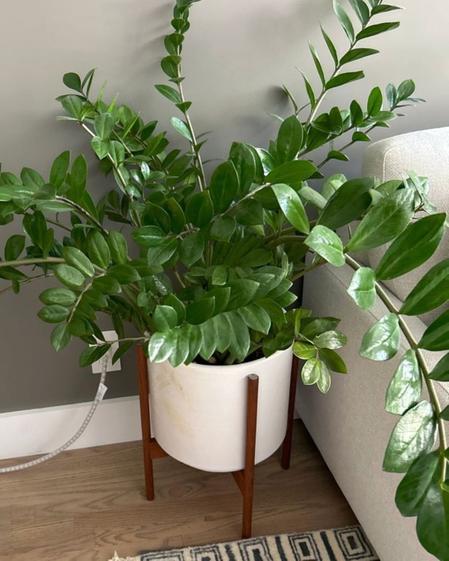
Leaning stems on an overgrown ZZ--time to prune and/or repot.
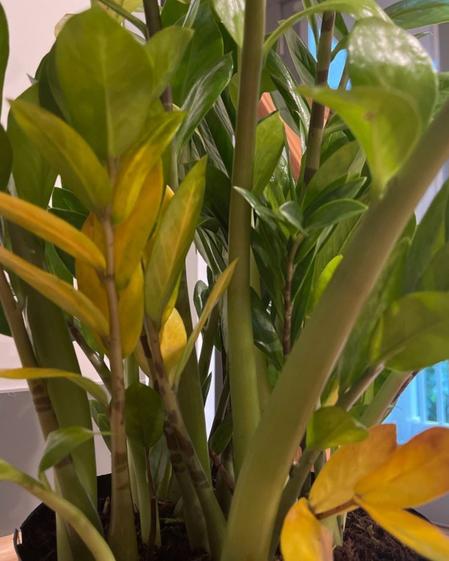
Yellow leaves, most likely due to overwatering.
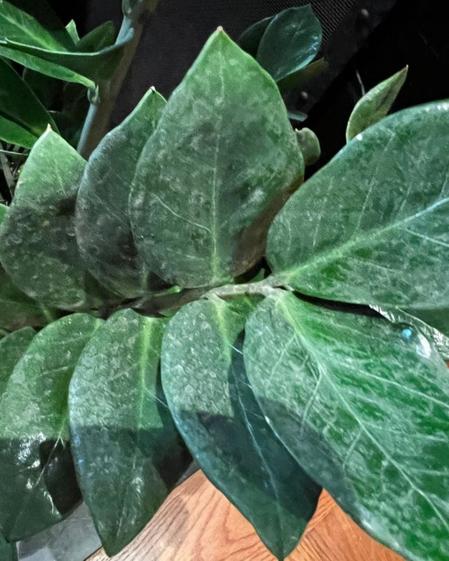
Very dusty leaves should be cleaned for best light absorption
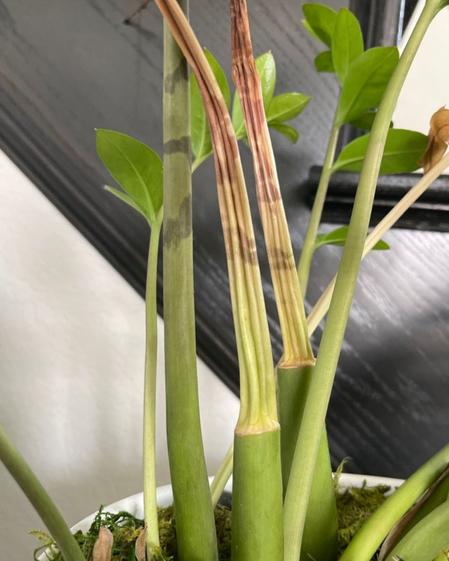
Mushy stems caused by overwatering.
Seasonal Care Tips
In spring and summer, water your ZZ plant regularly, allowing the soil to dry between waterings, and fertilize monthly to support growth. As temperatures drop in fall and winter, reduce watering, reduce or stop fertilizing, and keep the plant away from cold drafts or direct heat sources to prevent stress.










